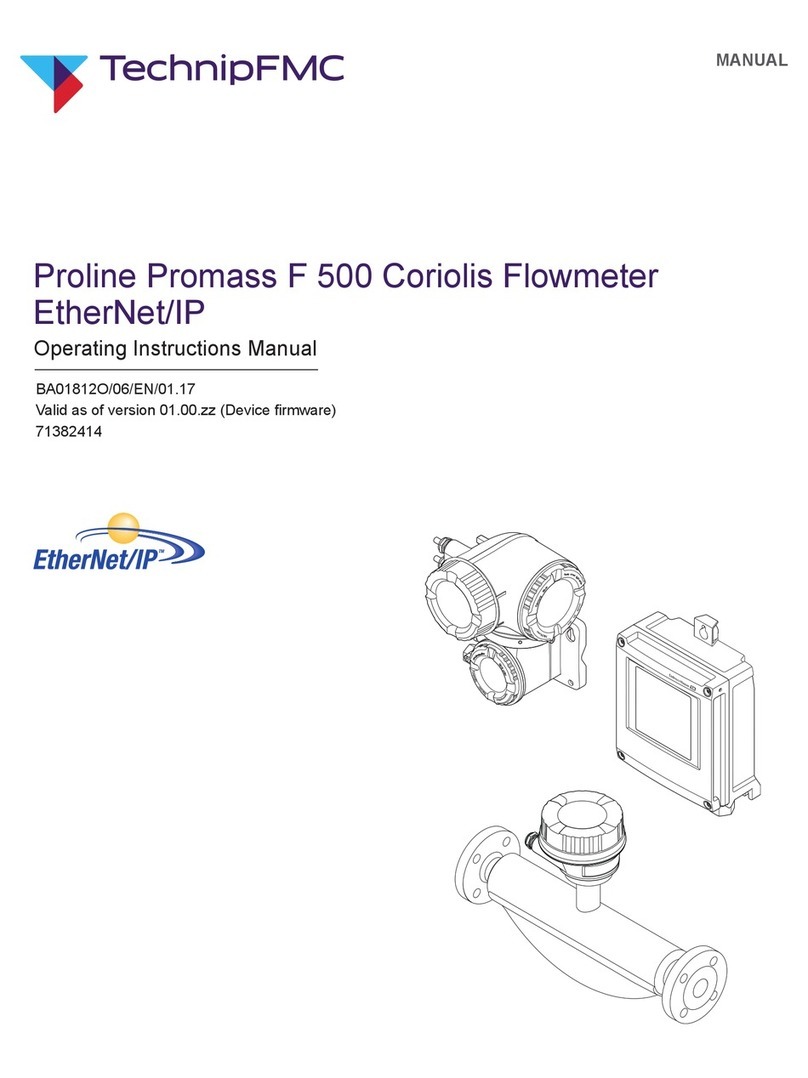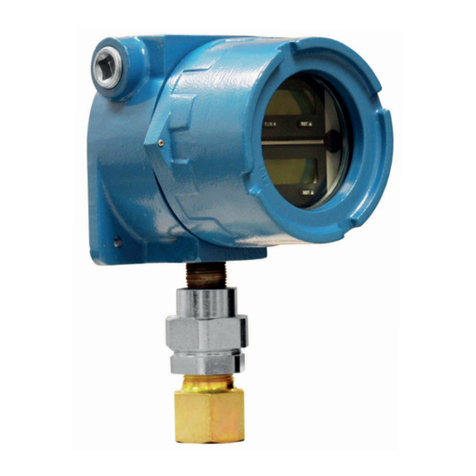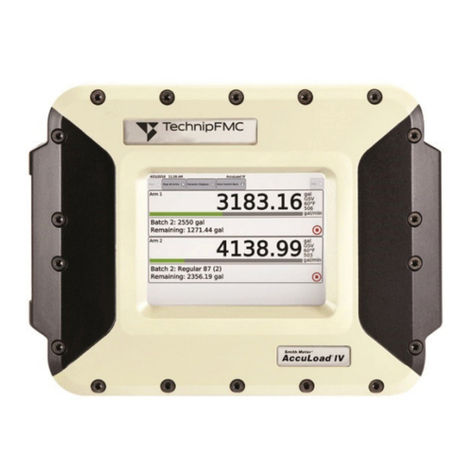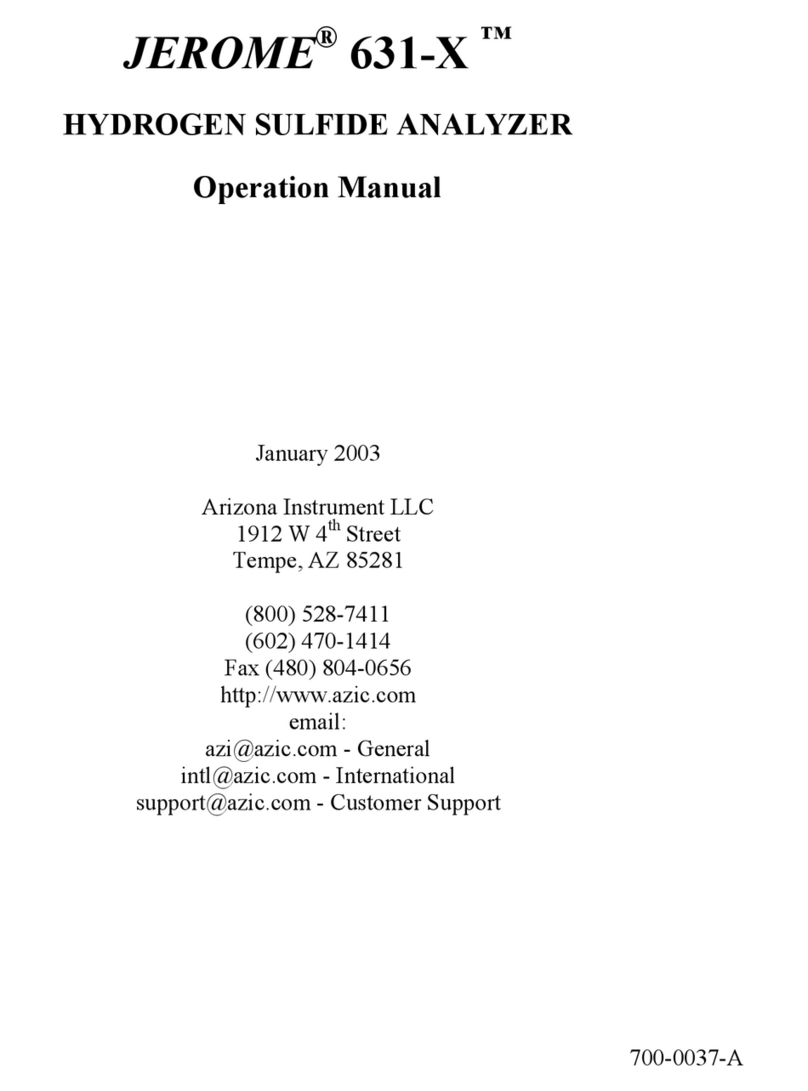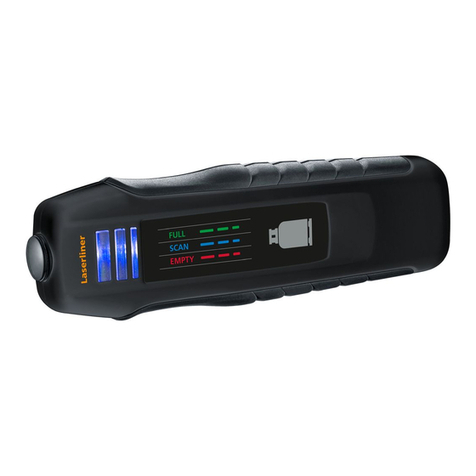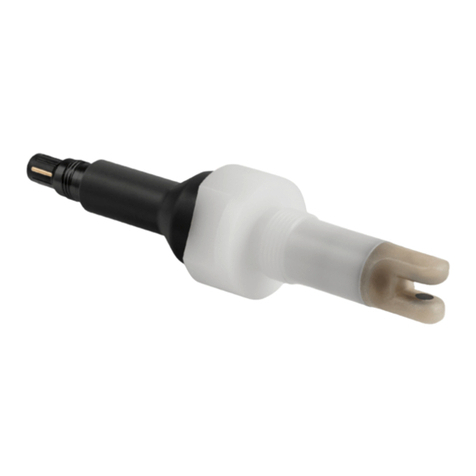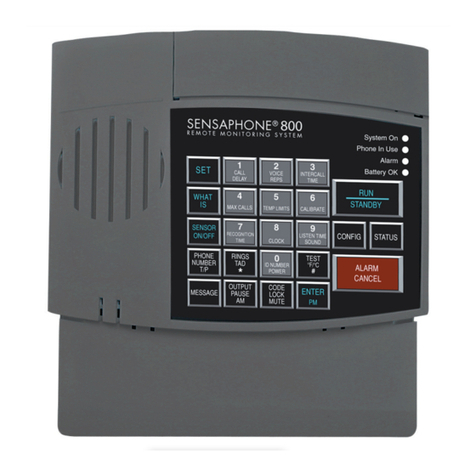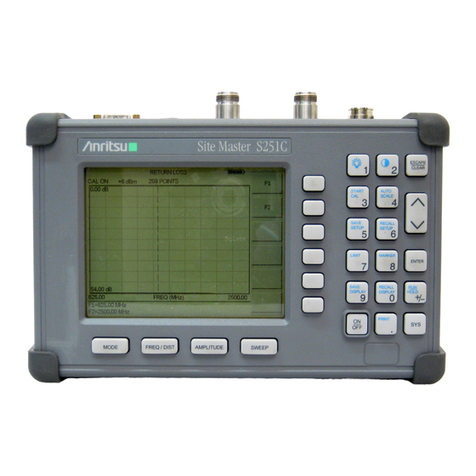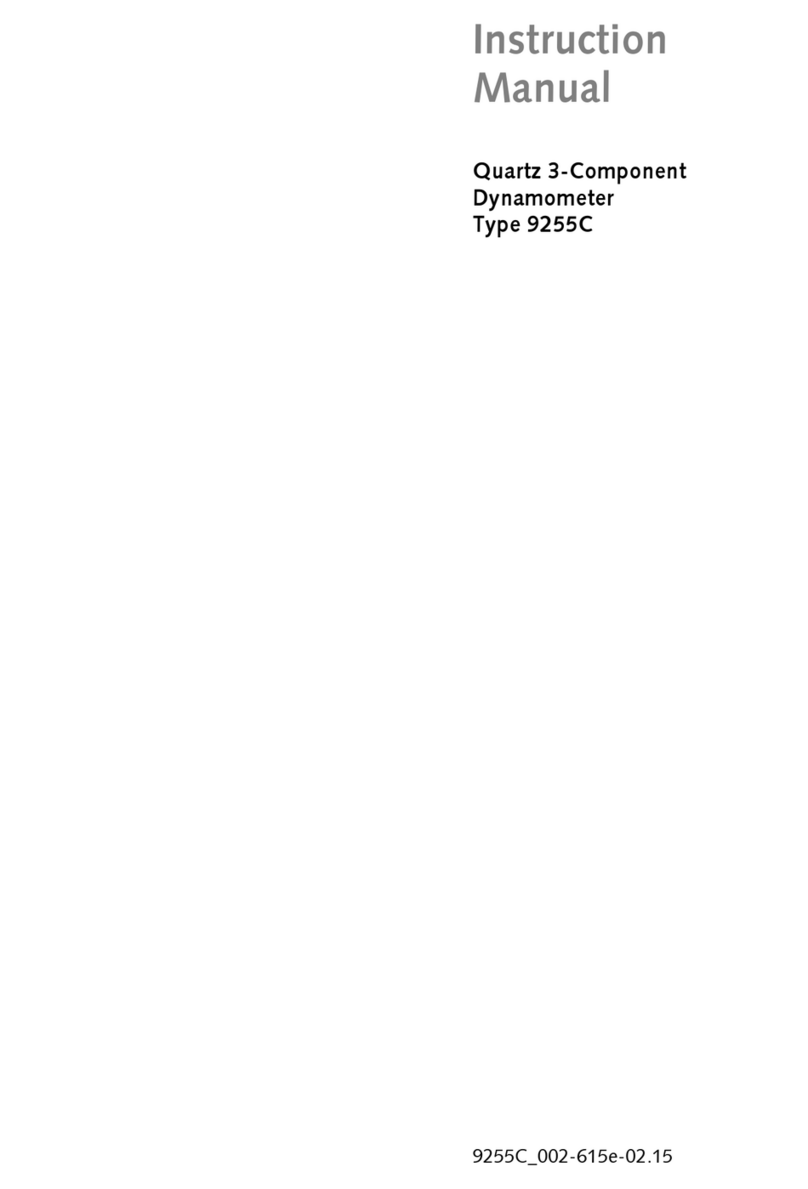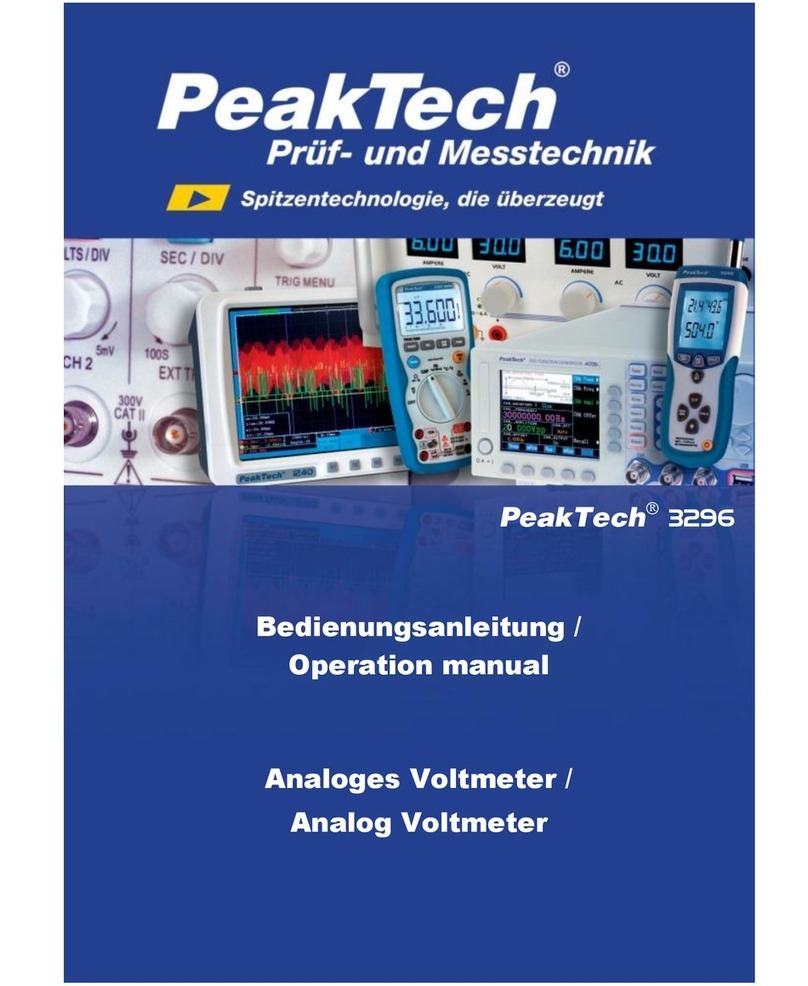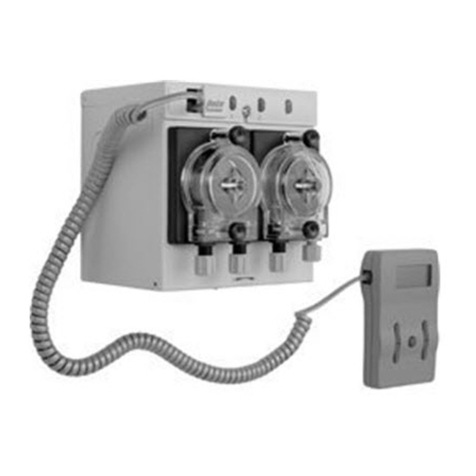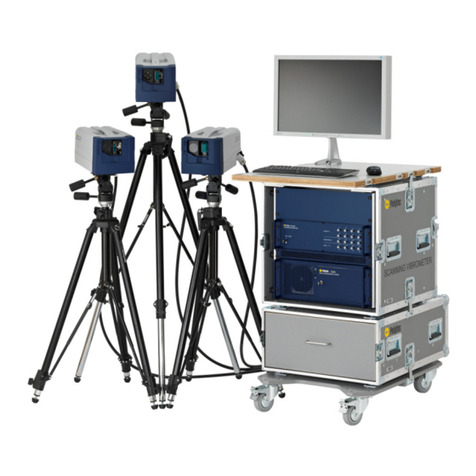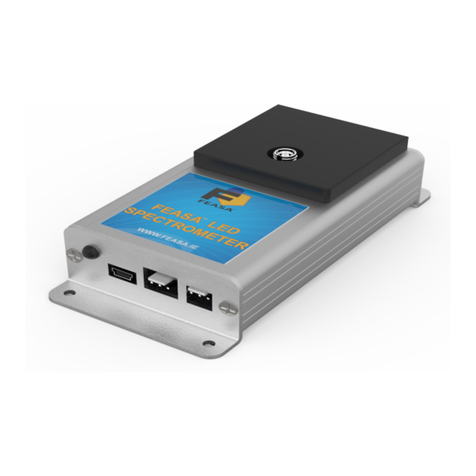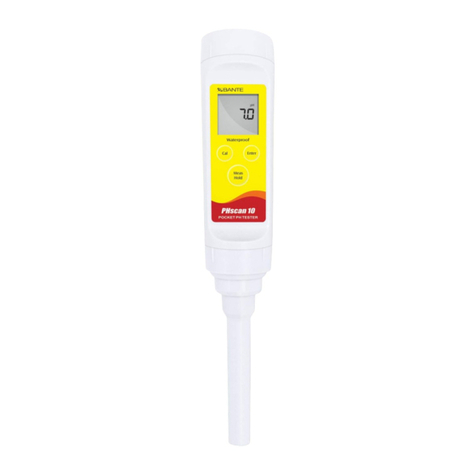TechnipFMC Smith Meter AccuLoad III User manual

Electronic Preset Delivery System
Smith Meter®AccuLoad®III with ALX Firmware
Installation Manual
Bulletin MN06135 Issue/Rev 1.3 (6/17)

Caution
The default or operating values used in this manual and in the program of the AccuLoad III
are for factory testing only and should not be construed as default or operating values for
your metering system. Each metering system is unique and each program parameter must
be reviewed and programmed for that specific metering system application.
Disclaimer
FMC Technologies Measurement Solutions, Inc. hereby disclaims any and all responsibility
for damages, including but not limited to consequential damages, arising out of or related to
the inputting of incorrect or improper program or default values entered in connection with
the AccuLoad III.

Receipt of Equipment
When the equipment is received the outside packing case should be checked immediately for any shipping damage.
If the packing case has been damaged, the local carrier should be notified at once regarding his liability. Carefully
remove the unit from its packing case and inspect for damaged or missing parts.
If damage has occurred during shipment or parts are missing, a written report should be submitted to the Customer Ser-
vice Department, FMC Technologies Measurement Solutions, Inc., 1602 Wagner Avenue, Erie, Pennsylvania 16510.
Prior to installation, the unit should be stored in its original packing case and protected from adverse weather
conditions and abuse.
Caution:
This equipment generates, uses, and can radiate radio frequency energy and, if not installed and used in
accordance with this Instruction Manual, may cause interference to radio communications. It has not
been tested to comply with the limits for a Class A computing device pursuant to Subpart J of Part 15 of
FCC Rules, which are designed to provide reasonable protection against such interference when operat-
ed in a commercial environment. Operation of this equipment in a residential area is likely to cause inter-
ference, in which case the user, at his own expense, will be required to take whatever measures may be
required to correct the interference.
Warning
These preset devices must be used with fail-safe backup equipment to prevent accidental runaway delivery of
product. Failure to provide backup equipment could result in personal injury, property loss and equipment damage.
Warning
On initial power-up of a new unit or after installation of a new computer board, there are several alarms that will
be triggered which cannot be cleared until the AccuLoad is programmed.
United States NIST Handbook 44 UR.3.5.1. and UR.3.5.2.
For compliance to United States NIST Handbook 44 UR.3.5.1. and UR.3.5.2., invoices printed using a mechanical
numeric-only printer (e.g., Smith Meter Load Printer) must contain in preprinted form the following information:
a. Volume corrected to 60 degrees F
b. API/C of E _____________________
c. Temperature ____________________
d. Gross Volume ____________________
where the API/C of E, temperature, and gross volume may be hand-written on the ticket. Refer to Handbook 44,
UR.3.5.1. and UR.3.5.2. for current requirements.

This page intentionally left blank.

Table of Contents
Section I - Introduction................................................................................................................................................1
Receipt of Equipment..............................................................................................................................................1
Warning and Precautions........................................................................................................................................1
Weights and Measures Requirements....................................................................................................................2
Section II - Pre-Installation Considerations ................................................................................................................3
Mechanical..............................................................................................................................................................3
Electrical..................................................................................................................................................................3
Environmental.........................................................................................................................................................4
Section III - Installation ...............................................................................................................................................5
Mechanical..............................................................................................................................................................5
Electrical..................................................................................................................................................................5
Input Frequency x2..............................................................................................................................................6
Start-Up ...............................................................................................................................................................6
General Requirements............................................................................................................................................6
Section IV - Diagrams.................................................................................................................................................7
Switch Settings..................................................................................................................................................... 10
Analog Module Settings (JP1 on EAAI)............................................................................................................... 11
Bi-State DC Inputs and Output Jumper Settings (JP1 on the BSE) .................................................................... 13
Pulse Inputs ......................................................................................................................................................... 15
Dual Pulse Inputs for Rev. 10.07 and Above Firmware (With Flow Controlled Additive).................................... 18
Promass 80, 83, and 84....................................................................................................................................... 33
Wiring Terminals, 4-20mA and 1-5 Vdc Inputs/Outputs ...................................................................................... 49
Digital Inputs ........................................................................................................................................................ 50
Wiring Terminals, Digital Inputs ........................................................................................................................... 51
Digital Outputs...................................................................................................................................................... 52
Wiring Terminals, Digital Outputs ........................................................................................................................ 53
Digital Inputs – AICB............................................................................................................................................ 67
Optional AICB Board(s) (Additive Inputs/Outputs)............................................................................................... 69
Communications (AICB Boards).......................................................................................................................... 72
Jumper Locations................................................................................................................................................. 72
Optional ComFlash Mass Storage Expansion Board .......................................................................................... 81
Section V - Maintenance ......................................................................................................................................... 83
Maintenance......................................................................................................................................................... 83
Battery replacement procedure............................................................................................................................ 83
Firmware updates ................................................................................................................................................ 84
Enclosure Maintenance....................................................................................................................................... 84
Special Environments .......................................................................................................................................... 85
Section VII - Completing the Installation.................................................................................................................. 86
Explosion-proof housing closure.......................................................................................................................... 86
Sealing ................................................................................................................................................................. 87
Section VIII - Related Publications.......................................................................................................................... 88

This page intentionally left blank.

Section I – Introduction
MN06135 Issue/Rev. 1.3 (6/17) 1
This manual is to be used for the installation of the
AccuLoad III Electronic Preset Controller with Accu-
Load III firmware. The manual is divided into the fol-
lowing sections: Introduction, Pre-Installation Con-
siderations, Installation, Diagrams, Maintenance,
Completing the Installation, and Related Publica-
tions.
Receipt of Equipment
When the equipment is received the outside pack-
ing, case should be checked immediately for any
shipping damage. If the packing case has been
damaged, the local carrier should be notified at once
regarding his liability. Carefully remove the unit from
its packing case and inspect for damaged or missing
parts.
If damage has occurred during shipment or parts are
missing, a written report should be submitted to the
Customer Service Department, FMC Technologies
Measurement Solutions, Inc., 1602 Wagner Avenue,
Erie, Pennsylvania 16510.
Before installation, the unit should be stored in its
original packing case and protected from adverse
weather conditions and abuse.
Warnings and Precautions
Before you begin please read all of the following
warnings and cautions to reduce the risk of injury,
equipment damage or malfunction.
Emergency Shutdown –The AccuLoad has an ex-
tensive set of built-in safety features.
IMPORTANT: The AccuLoad should never be relied
upon to act as the primary safety system control for
the flow valve and pump controls, i.e. emergency
stop, overfill, ground protection, etc. These should
always be handled by separate systems specifically
designed for that application. For example, Safety
systems specifically to meet SIL requirements. Any
power control circuits from these external systems
shall be wired in series ahead of the AccuLoad to
remove power to the ancillary devices.
Hazardous Voltages –There are hazardous volt-
ages involved in the installation and maintenance of
the AccuLoad and only qualified individuals should
perform installation.
Hazardous Locations –The S and Q models are
approved for use in an explosive (Class I, Div. I,
Groups C & D and Zone 1 Ex d ia, IIB Gb) atmos-
phere but there are specific installation methods re-
quired to produce a comprehensive explosion-proof
system. This manual provides guidance for the Ac-
cuLoad installation only. In general, keeping the
front cover bolted close in accordance with the in-
structions in Section VII is the key to maintaining ex-
plosion protection.
Any modification of the AccuLoad housing inval-
idate the hazardous location rating of the Accu-
Load.
•Do not replace the bolts in the front cover
except with those supplied by the manufac-
ture. Using unapproved bolts invalidates the
explosion-proof rating of the enclosure.
•Do not drill or machine the housing.
•Do not attempt to replace the touchscreen or
glass except as part of the factory supplied
assembly.
Electrostatic Discharge Precautions – The elec-
tronic components in the AccuLoad are susceptible
to damage by static discharge. To minimize the risk
of damage, the following precautions should be fol-
lowed:
•Before touching a circuit board with hands or
tools, personnel/tools should be grounded
using a wrist strap.
•Avoid touching components or traces on the
circuit boards and handle by the edg-
es/mounting holes.
•Circuit boards should be kept in conductive
bags when not installed.
ATEX / IEC Installations –There are special re-
quirements for ATEX approved installations. Please
refer to Section III for a detailed list of the specific
requirements.
RF Radiation - The AccuLoad generates, uses, and
can radiate radio frequency energy and, if not in-
stalled and used in accordance with this Manual,
may cause interference to radio communications. It
has not been tested to comply with the limits pursu-
ant to Part 15 (CFR 47) of FCC Rules, as electronic
control equipment utilized by an industrial complex is
exempt from the rules.

Section I – Introduction
MN06135 Issue/Rev. 1.3 (6/17) 2
Operation of this equipment in a residential area
may cause interference, in which case the user, at
his own expense, will be required to take whatever
measures that may be required to correct the inter-
ference. The AccuLoad has been evaluated against
the standard EN 61326-1: “Electrical equipment for
measurement, control and laboratory use” and has
been found to comply to the European Community
EMC Directive 2014/30/EU.
Weights and Measures Requirements
The AccuLoad is a device marketed for a global
market. Requirements vary depending on the region.
It is a user requirement to verify that the AccuLoad is
programmed and operated in a manner consistent
with local codes and that proper notification (permit
for use) or registration has been filed with the local
authority or jurisdiction.

Section II – Pre-Installation Considerations
MN06135 Issue/Rev. 1.3 (6/17) 3
Mechanical
In addition to the following, all previous warnings
and cautions should be reviewed before installation.
1. A solid base (pedestal or shelf) should be used
to support the explosion-proof AccuLoad III
housing.
Weight: = 50 lb. (22.7 kg) ALIII-S Hardware
Weight: = 125 lb. (57.5 kg) ALIII-Q Hardware
2. The location and the height of AccuLoad III
should be selected to permit easy viewing of the
display and to provide convenient access to the
keypad by all users.
3. Access for servicing AccuLoad III is through the
front cover. For ease of service and removal of
parts the cover must swing open more than 90°.
The explosion-proof AccuLoad III is hinged on
the left.
4. Conduit entry to the explosion-proof AccuLoad
III is both through the bottom and top. The top
entries are used for those units where the CI-
VACON Grounding and overfill board is installed.
For the ALIII-S hardware there are three 1-1/4"
11.5 NPT conduit entrances in the bottom of the
unit and two 1" 11.5 NPT conduit entrances in
the top of the unit. For the ALIII-Q hardware
there are two 1-1/4" 11.5 NPT conduit entrances
and five 1" 11.5 NPT conduit entrances in the
bottom of the unit and one 1" 11.5 NPT conduit
entrance in the top of the unit.
5. In warm climates, AccuLoad III should be shad-
ed from direct sunlight. The maximum external
temperature of the AccuLoad III housing must
not exceed 140°F (60°C) to ensure that the in-
ternal temperature limit is not exceeded.
Electrical
1. All DC wiring must be routed into AccuLoad III
through the conduit entries located in the bottom
of the housing. Do not route DC and AC wiring
through the same conduit entry.
2. The DC signal wires must be multi-conductor
shielded cable of 18 to 24 AWG minimum strand
copper.
Note: The following recommendations are based on our
knowledge of the electrical codes. The local electrical codes
should be reviewed to ensure that these recommendations follow
the local code. Also installation manuals of all the equipment be-
ing wired into the AccuLoad should be reviewed for transmission
distances and wire recommendations.
Table 1. Typical Wire Sizes
Equipment Number &
Gauge of
Wire
Belden
Number or
Equivalent
Transmitters 4 / 18 Ga.
4 / 20 Ga. 9418
8404
Temp. Probes
Density & Pressure
Transmitters 4 / 22 Ga. 8729
OR
9940
EIA-232
Communications 3 / 24 Ga. 9533
EIA-485
Communications 4 / 24 Ga. 9842
Table 2. Maximum Cable Length and Baud Rate
(EIA-232)
Baud Rate Feet Meters
38,400 250 75
19,200 500 150
9,600 1,000 305
4,800 2,000 610
2,400 4,000 1,220
1,200 4,000 1,220
Table 3. Maximum Cable Length and Baud Rate
(EIA-485)
Baud Rates
Feet
Meters
1,200 to 38,400 4,000 1,220
Note: For Ethernet communications, refer to standard IT
practices for connecting any AccuLoad using routers,
hubs, switches, etc.

Section II – Pre-Installation Considerations
MN06135 Issue/Rev. 1.3 (6/17) 4
3. All AC wiring must be routed into AccuLoad III
through the conduit entries located in the bottom
of the housing. Connectors sized for a maximum
of 14-gauge wire, consult the local electrical
codes for the minimum AC wire size required for
your application. Do not route AC and DC wiring
through the same conduit entry.
4. All AC wiring should be stranded copper and
must comply with federal, state and local codes
and specifications.
5. Two separate AC circuits must be provided from
the breaker panel. One circuit will supply isolat-
ed power to the AccuLoad III electronics (in-
strument power). The second circuit will supply
power to the external devices.
6. For proper operation the AccuLoad III must be
earth grounded. The grounding point should be
as close to the unit as possible. To ensure proper
earth ground:
a) The resistance between the ground lug in
the AccuLoad III and the grounding point
must not exceed 2 Ω.
b) The proper grounding point is a ½" to ¾" di-
ameter copper stake that extends into the
water table. Where this is not practical, a
ground plane may be used.
Note: Electrical conduit, piping, and structural steel are
not considered proper grounding points for equipment
using electronics.
c) No other devices, except AccuLoad IIIs and
ancillary equipment such as load printers,
should be connected to any point in the
grounding circuit.
7. If external relay permissives are used in series
with AccuLoad III relays, an RC network must be
placed in parallel with the permissive to prevent
a false turn-on of the AccuLoad III relays. Rec-
ommended RC network = 0.1 UF capacitor and
a 680 Ωresistor (Electrocube part number RG
2031-11).
8. Interposing relays must be installed between the
pump controller, alarming device, and the Accu-
Load III permissive sense relays.
Environmental
Models ALIII-S-XP and ALIII-Q-XP
The enclosures of Explosion / Flame proof models
are manufactured from aluminum alloy, and are de-
signed to be operated in normal environmental con-
ditions free of corrosive agents.
In areas including but not limited to environmentally
corrosive atmospheres, special considerations for
additional environmental protections shall be made if
installing into near shore areas that are subject to
wind borne salt sea water spray and subject to pos-
sible continuous accumulations of wetted salt water
on the equipment. The recommended protection is
exclusion of the environment by placing the equip-
ment into secondary protected environment such as
a kiosk or a control room. If exclusion of the envi-
ronment is not possible, then extra means must be
taken to maintain the equipment integrity, this in-
cludes frequent cleaning and inspection intervals.
See Section IV for additional information.
In areas where the ambient temperature is very
high, it is recommended that the equipment be in-
stalled under a canopy / sun shield to limit direct
sunlight radiation.
In areas of high humidity (tropical) or with varying
temperature swings, it is recommended to place
TechnipFMC P/N 647 001 443 or similar desiccant
packs inside of the enclosures, and to maintain
these while in service.

Section III – Installation
MN06135 Issue/Rev. 1.3 (6/17) 5
Mechanical
See Pre-installation Considerations.
Electrical
ATEX & IEC EX - Approved Units
(a) Cable Entry must be in accordance to IEC
60079-1 section 13:
For systems utilizing cable glands, the gland
and/or thread adaptor must be Ex certified.
The cable end must be securely installed
and, depending on the cable type, be
properly protected from mechanical dam-
age. Requirements outlined in Section 10.4
of IEC 60079-14 shall be followed.
(b) Cable Entry must be in accordance to IEC
60079-1 section 13:
For systems utilizing conduit, an Ex certified
sealing device must be immediately at the
entrance of the enclosure. Any unused entry
must be suitably blocked with an Ex d IIB
certified plug. Requirements outlined in Sec-
tion 10.5 of IEC 60079-14 shall be followed.
(c) Installation:
General Installation to be in accordance with
IEC 60079-14, wiring system to be in ac-
cordance with section 9.
(d) Flame Path Dimensions:
AccuLoad Joint Dimensions: Flanged joint
widths are 19.05 mm minimum and gaps are
0.051 mm maximum. Flameproof joints shall
be maintained as outlined in section 10.4 or
IEC 60079-14.
(e) Cover Fasteners:
AccuLoad Special Fasteners: Cover Bolts –
steel grade 12.9, M8 x 1.25.
(f) Cautions and Warnings:
Caution: To prevent ignition of hazardous
atmospheres, disconnect from supply circuit
before opening, keep tightly closed when
circuits are in operation.
Warning:Contains internal battery-powered
circuit, to prevent ignition of hazardous at-
mospheres, do not open enclosure unless
area is known to be non-hazardous.
General Requirements
It is imperative that the electrical installation be per-
formed by a competent individual that is familiar with
associated risks involved with the installation, opera-
tion, and maintenance, of electrical equipment in
hazardous (classified) locations. This individual must
possess knowledge of local, national electrical
codes, and/or ordinances concerned with hazardous
location safety requirements. It is recommended
(may be required in some jurisdictions) that the final
installation should be verified / inspected by the au-
thority having jurisdiction before placing the equip-
ment into service.
Electrical installations in hazardous areas have fea-
tures specifically designed to make them suitable for
use in such locations and it is the operator’s respon-
sibility to maintain the integrity of those special fea-
tures.
The operator must ensure that electrical equipment
is:
a. Installed and operated correctly
b. Monitored on a regular basis
c. Maintained with due regard to safety
d. Follow all requirements of National Electrical
Code for the country of installation.
e. AC Circuits must be isolated from DC circuits
and brought into the unit through their respec-
tive conduit openings.
f. Be sure all connections on the terminal blocks
are tight.
g. All shields must be connected to terminals 3,
13, 14, or 15 on terminal block TB4 on the EAAI
Board or terminal 3 and 4 on terminal block
TB6 on the KDC Board, or terminals 9 and 10
on TB14 on the BSE Board.
All exposed shields must be properly insulated
to prevent short circuits to other terminals or to
the chassis. The shield at the device (e.g., tem-
perature device, transmitter, etc.) must be cut
back to the insulation and taped off. All shields
should be continuous. If splices are required,
they must be soldered and properly insulated. If
other communicating devices are used with the
AccuLoad III, refer to the manual for that unit for
shielding information. Shields for other com-
municating equipment should not be terminated
in the AccuLoad III.

Section III – Installation
MN06135 Issue/Rev. 1.3 (6/17) 6
Note: Shields must not be terminated at the ground lugs.
h. Sufficient slack should be provided for the wir-
ing in the AccuLoad III to permit easy removal
of the boards. With sufficient slack, the terminal
blocks can be removed and laid back out of the
way so that the boards can be replaced without
removing individual wires.
i. There is a ground lug provided in the unit. The
wire from the lug should be connected to the
proper grounding point. See Pre-Installation
Considerations, page 2.
j. Typical electrical installation diagrams are pro-
vided in the following sections to show the Ac-
cuLoad III and ancillary equipment. Before wir-
ing the ancillary equipment, refer to its installa-
tion manual.
Installing and Removing the Analog I/O Module
Caution: Turn off the power at the unit prior to installing
or removing the Analog I/O Module. Failure to do so will
damage modules.
Care should be taken when installing or removing
the Analog I/O modules so as not to damage the
board or the module. To install the module, line up
the alignment pins with the socket and push down
on the module. Once it is seated, screw in the
mounting screw until tight. Do not over-tighten the
screw. To remove the modules from the board, loos-
en the mounting screw and pull up on the module.
Figure 1. Analog Modules
Input Frequency x2
If the application requires a pulse rate that is higher
than the meter is capable of putting out, the Accu-
Load III can multiply the incoming pulses times 2.
This option is activated by switches located on the
PIB boards. The PIB boards are located on the EAAI
and the BSE boards.
Figure 2. Connector and Switches on PIB Board
The default setting from the factory is “times 1.” The
switch is closed (ON). To multiply the incoming puls-
es times 2, push the switch of the incoming pulse
channel to the open (OFF) position. The switches
are located on the PIB boards, as shown in Figure 2.
The PIB board that is located on the EAAI board is
for pulse inputs 1 through 6. The PIB board that is
located on the BSE board is for pulse inputs 7
through 12.
Note: The switches correspond to the pulse input channels (i.e.,
Meter Pulse In #1 is equal to Switch #1.) See Table 6 for corre-
sponding Pulse Input channels.
Start-Up
When the wiring is completed and verified, power
may be applied to the unit. The displays should light,
indicating that the AccuLoad III is ready for Start-Up.
Please reference the Operator Reference Manual.

Section IV– Diagrams
MN06135 Issue/Rev. 1.3 (6/17) 7
Figure 3. AccuLoad III-Q Dimensions

Section IV – Diagrams
MN06135 Issue/Rev. 1.3 (6/17) 8
Figure 4. AccuLoad III-S Dimensions

Section IV – Diagrams
MN06135 Issue/Rev. 1.3 (6/17) 9
Figure 5. KDC Layout
Configurable jumper locations are heavily circled on the diagram above. It is important to note that all but one of
these jumpers, J22, are factory defaults and should not be configured by the user. The proper settings are provid-
ed below so if one of these is accidentally changed, it can be returned to its original position. J22 is the jumper
used to zero the passcodes and security input access level (151-157). Jumpers are configured using the plugs
that fit over the jumper prongs. A jumper with no prongs plugged, or with one prong plugged, is OUT. A jumper
with both prongs plugged is IN.
Note: Should Program Mode be inaccessible after changing PROMs, or if the operator loses or forgets the access code, set J22 to In, then
power up. Entry to the program mode is provided. Check passcodes and remove jumper J22 when finished.
1 – In
4 – Out
7 – Out
10 – Out
13 – In
16 – Out
25 – Out
2 – In
5 – Out****
8 – Out
11 – In
14 – Out
23 – In*
3 – In
6 – In***
9 – Out
12 – Out
15 – In
24 – In**
* Jumper 23 if removed indicates there is not a BSE board in the System (ALIII-S Hardware)
** Jumper 24 if removed indicates there is only one display (ALIII-S Hardware)
*** For units shipped prior to October 2001: J6 must be in the “in" position for Optrex Model DMF5003N.
For units shipped after October 2001: J6 must be in the “out" position for Model MTG-2406 displays.
**** For units shipped prior to August 2005: J5 must be in the “out” position. After August 2005 and for all units with Rev. B displays,
the Jumper J5 must be in the “in” position.

Section IV – Diagrams
MN06135 Issue/Rev. 1.3 (6/17) 10
Switch Settings
A new 8 pin DIP switch will be available for use (SW SW1-8). The switch will be utilized as follows:
SW1-1 force firmware upgrade (powers up waiting for firmware upgrade)
SW1-2 SW1-3
OFF OFF use programmed IP address
ON OFF use 192.168.0.1
OFF ON use 10.0.0.1
ON ON use DHCP
Figure 6. EAAI Layout
The user-configurable jumper on the EAAI board is indicated by a circle and arrow in the diagram above. See the
table on the following page for an explanation of analog module settings. This jumper has been configured for the
modules that were shipped with the unit. Changes should only be made if different modules are added or deleted.
Modules must be installed with inputs first, followed by outputs.
Ribbon Cable

Section IV – Diagrams
MN06135 Issue/Rev. 1.3 (6/17) 11
Analog Module Settings (JP1 on EAAI)
6 Inputs, 0 Outputs
2 Inputs, 4 Outputs
5 Inputs, 1 Output
1 Input, 5 Outputs
4 Inputs, 2 Outputs
0 Inputs, 6 Outputs
3 Inputs, 3 Outputs
Table 4. Analog Module Settings

Section IV – Diagrams
MN06135 Issue/Rev. 1.3 (6/17) 12
Figure 7. BSE Layout
Note: JP1 3 through 6 define the number of BIOB inputs. JP1 1 and 2 are not used.

Section IV – Diagrams
MN06135 Issue/Rev. 1.3 (6/17) 13
Bi-State DC Inputs and Output Jumper Settings (JP1 on the BSE)
8 Inputs, 0 Outputs
3 Inputs, 5 Outputs
7 Inputs, 1 Output
2 Input, 6 Outputs
6 Inputs, 2 Outputs
1 Inputs, 7 Outputs
5 Inputs, 3 Outputs
0 Inputs, 8 Outputs
4 Inputs, 4 Outputs
Table 5. Bi-State Inputs and Outputs

Section IV – Diagrams
MN06135 Issue/Rev. 1.3 (6/17) 14
Figure 8. KDC/EAAI/PIB/BSE Boards
Table of contents
Other TechnipFMC Measuring Instrument manuals
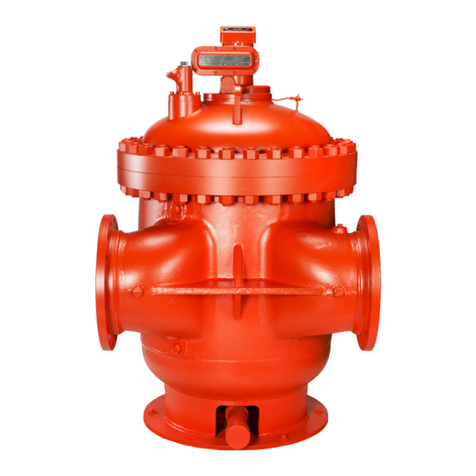
TechnipFMC
TechnipFMC Smith Meter JB10 S1 User manual
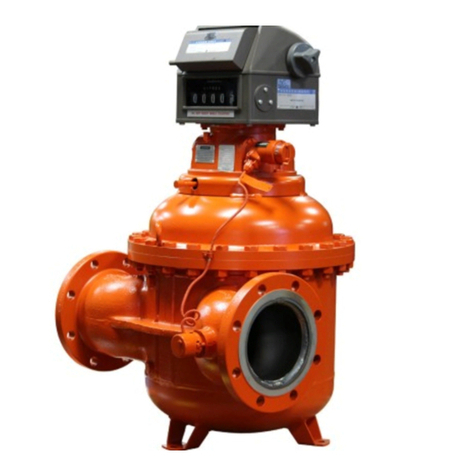
TechnipFMC
TechnipFMC Smith Meter C2 User manual
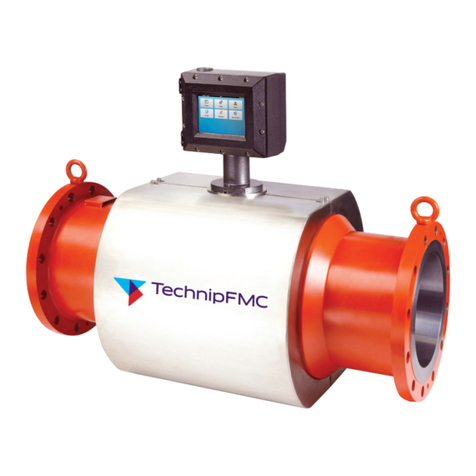
TechnipFMC
TechnipFMC Smith Meter MPU C Series Instruction manual
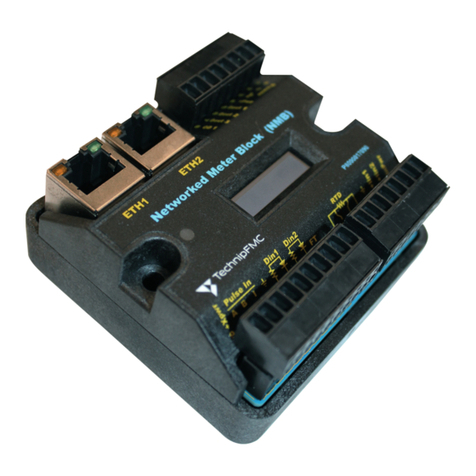
TechnipFMC
TechnipFMC Smith Meter Instruction manual
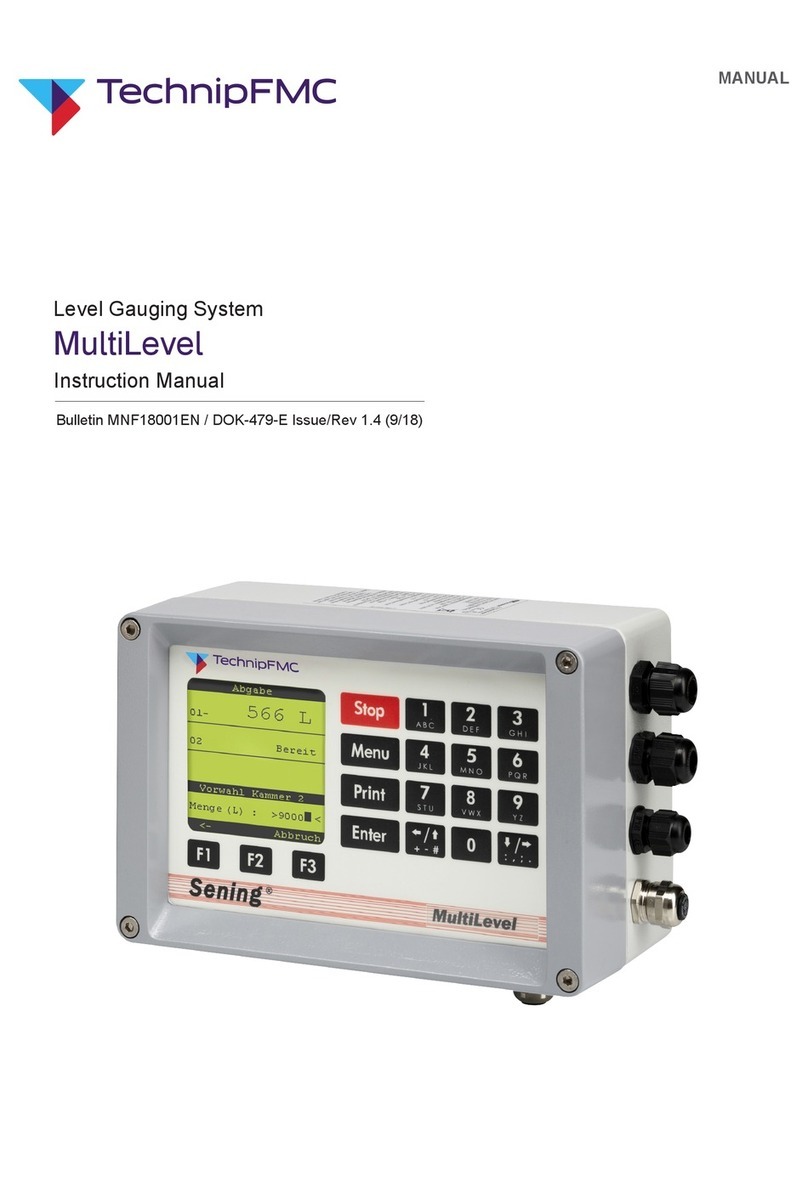
TechnipFMC
TechnipFMC Sening MultiLevel User manual
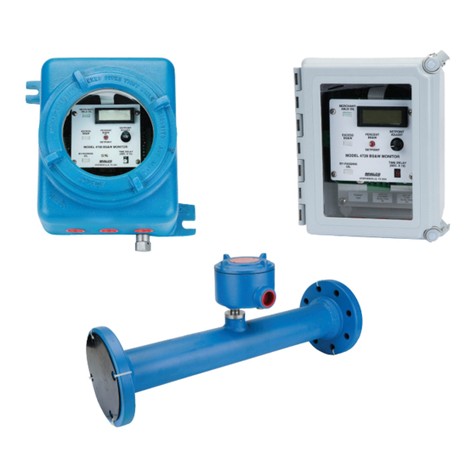
TechnipFMC
TechnipFMC 4728 User manual

TechnipFMC
TechnipFMC Smith Meter PRIME 4 User manual

TechnipFMC
TechnipFMC Proline Promass E 500 Instruction Manual
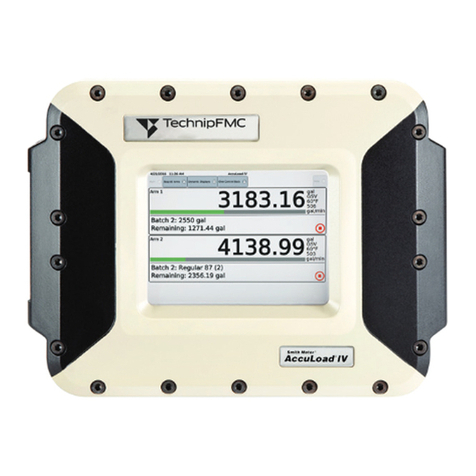
TechnipFMC
TechnipFMC Smith Meter AccuLoad IV Series Manual
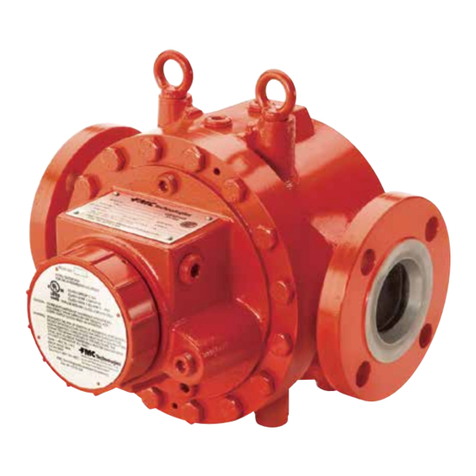
TechnipFMC
TechnipFMC Smith Meter Genesis Series User manual
